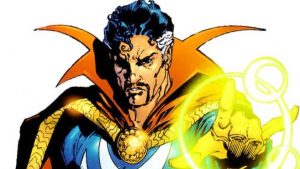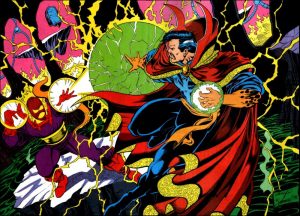Can we talk about the Doctor for a moment? No, not that doctor. I’m talking, of course, about Doctor Strange.
 Some are predicting that Marvel’s Doctor Strange movie – despite casting Benedict Cumberbatch as Strange – is cinematic chloroform, sure to put unfamiliar audiences to sleep, if the B-list character can even coax them to the theatre in the first place.
Some are predicting that Marvel’s Doctor Strange movie – despite casting Benedict Cumberbatch as Strange – is cinematic chloroform, sure to put unfamiliar audiences to sleep, if the B-list character can even coax them to the theatre in the first place.
Well, just as Doctor Strange would do, let’s trap naysayers in a pocket dimension between worlds, letting them fight it out with Dormammu. The loser is sealed off for the rest of eternity, or until the 2016 cinematic release, whichever is first.
Or I can give you an introduction to Doctor Strange with hopes that it enthuses you for the movie. Which would you prefer?
An introduction to Doctor Strange: The Basics
Let’s start with the basics of Doctor Strange. Introduced in issue #110 of Strange Tales (1963), Dr. Stephen Strange was a gifted and egotistical surgeon who lost the use of his hands to an auto accident. Desperate to regain his surgical skills, Strange resorted to magic and sought out the Ancient One. Instead, the Ancient One trained him to become Master of the Mystic Arts and the Sorcerer Supreme of Earth.
So, yeah, that’s pretty self-explanatory, huh? What else?
What are Doctor Strange’s Powers?
As Master of the Mystic Arts, Doctor Strange is one of the most powerful sorcerers in Marvel 616. The character resides not in the typical of space of mutant, tech-based, or super-serum realm of heroes, he instead represents magic in the Marvel Universe.
 Doctor Strange uses mystical energy via spells and incantations. This is illustrated in the comics by:
Doctor Strange uses mystical energy via spells and incantations. This is illustrated in the comics by:
- Projection of mystic energy as bolts, shields, or binds,
- Energy appearing like electricity,
- Manipulation of matter or transmutation of matter,
- Controlling the elements,
- Opening or sealing mystical portals to other realms, including teleportation or dimensional travel,
- Reality warping and casting illusions,
- Invisibility and intangibility through astral projection,
- Mental powers such as telepathy and telekinesis,
- Communication with the dead and spiritual entities,
- Seeing the future or past,
- Summoning supernatural beings (like demons),
- Or using the powers of supernatural items.
Reading through the above bullets illustrates that being a wizard has its privileges.
The Sorcerer Supreme also possesses magical artifacts, two of which are particularly epic in Doctor Strange’s 50+ years in the comics: The Eye of Agamotto and the Cloak of Levitation.
The Eye of Agamotto is an artifact which extends Dr. Strange’s psychic abilities, along with a host of other stuff that I, quite frankly, can’t keep track of. Similar to Thor’s Mjolnir, the Eye of Agamotto can only be used by those it deems as worthy.
The Cloak of Levitation acts as a third set of hands for Dr. Strange, responding to his thoughts to entangle opponents and shield him from attacks. Also, as the name would suggest, it allows him to fly and levitate as well.
Required Reading for Doctor Strange
His stories have featured Lovecraftian monsters, demons and satanic figures, vampires, werewolves, D-list supervillains, eldritch power, and creatures from the realm of Nightmare, so it’s difficult to suggest required reading that serves as an introduction to Doctor Strange.
 Doctor Strange is also a difficult character to get right, the reason being that his magical nature requires writers and artists to stretch the limits of their imaginations. Doctor Strange was a man of science who found himself wholly beyond science. Doctor Strange is Sorcerer Supreme – Master of the Mystic Arts – yet the magic can still surprise him, confound him, and overcome him. A writer and artist needs to hit that beat.
Doctor Strange is also a difficult character to get right, the reason being that his magical nature requires writers and artists to stretch the limits of their imaginations. Doctor Strange was a man of science who found himself wholly beyond science. Doctor Strange is Sorcerer Supreme – Master of the Mystic Arts – yet the magic can still surprise him, confound him, and overcome him. A writer and artist needs to hit that beat.
In addition, Doctor Strange is…well, strange. He’s a cowl-wearing, funky-facial-hair-having, bald-manservant-owning, Clea-and-Night-Nurse-loving wizard. He’s Lando Calrissian meets Gandalf meets H.P. Lovecraft. How do you sum that up in a single comic volume?
Here are some reasonable places to start:
- Strange Tales #110-#146 The duo of Stan Lee and Steve Ditko started it all back in to 60’s, breaking new ground in terms of the breadth of the ever expanding Marvel Universe. Stephen Strange meant the world of Marvel was not limited to the waking world or the realms of reality.
- Doctor Strange #1-5 (1974) was the source for the Doctor Strange television movie that really is worth a look. It’s psychedelic like some good Pink Floyd.
- Doctor Strange #59-62 (1983) was a story that centered on the destruction of all vampires on earth, and featured an epic battle between Doctor Strange, the Avengers, and Blade against Dracula and his legion of bloodsucking undead.
- Doctor Strange and Dr. Doom: Triumph and Torment (1989) was a tragic tale illustrating the compassionate side of Stephen Strange as he helped Dr. Doom. It’s self-contained and thoughtfully done.
- The New Avengers (v2) is where Brian Michael Bendis modernized Doctor Strange, including clever chronicling of his spells and incantations. The story featured Doctor Strange searching for a new Sorcerer Supreme on the heels of the death of Doctor Voodoo.
But I think the most succinct introduction to Doctor Strange is in the pages of Doctor Strange: The Oath (2006) by Brian K. Vaughn. (Click here to buy it.)
It’s modern and explored Stephen Strange the man, the wizard, and the physician. The story also serves as a good introduction to Wong, Strange’s man-servant, as well as introducing the character Night Nurse who – spoiler alert – becomes Strange’s new romantic interest.
The series serves as a great primer, giving the origin and concept concept of Doctor Strange while also letting the metaphysical side fly free. The Oath gets the roots of the character, plus pushes Strange into the modern Marvel Universe.

